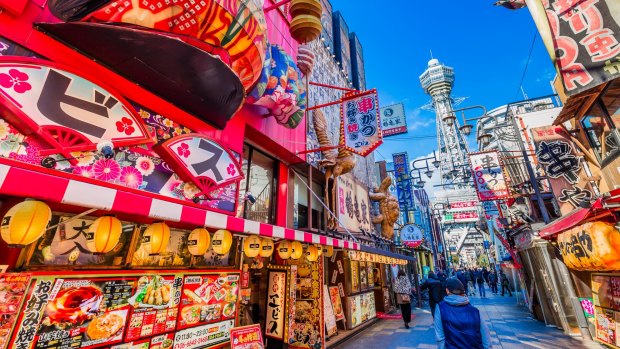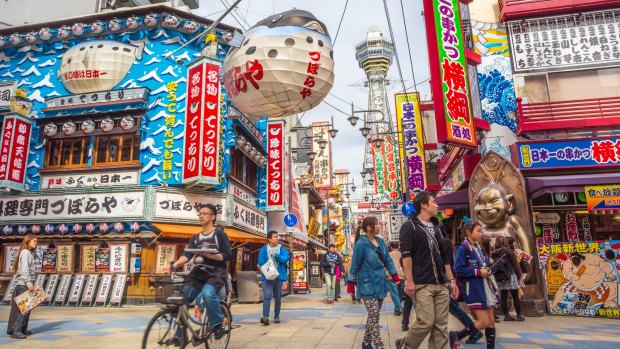This was published 4 years ago
Osaka tour, Japan: Neon charms in Shinsekai, Osaka's former fun park
By Lesley Holden

Shinsekai district in Osaka, Japan.Credit: Shutterstock
Shin-sekai or 'New World' is a run down district in Osaka. The faded aspirations inherent in its name and gaudy neons, suggest the grit and glamour of old Osaka.
This 'New World' was built in 1912 after the resounding success of the Fifth National Industrial Exhibition in 1903 in Osaka.
Shin-sekai, was a nod to modernity as a city of the future. The northern half of the city was modelled on New York and the southern half on Paris, reflecting an increasing interest in the West.

Vintage neon: Shinsekai is a tourist drawcard.Credit: Alamy
It included a Luna Park with an aerial tram connected to the new Tsutenkaku Tower. Modelled on the Eiffel Tower with a base inspired by the Arc de Triomphe, it was the second tallest tower in East Asia and became the symbol of Osaka.
Luna Park closed in 1923 without trace. In 1943 a fire destroyed the tower and the scrap metal was used for the war effort. Authorities were not able to future proof the area against changing taste, war and new competing forms of distraction and the area became a shabby, seedy part of town.
Today nostalgia and retro charm are the draw cards. Decades of neglect have largely preserved the area and its shared history with a heritage red light district and a homeless labourers' neighbourhood that fringe the area. A visit begins at twilight just as the neons and the 1950s replacement Tsutenkaku Tower's vein blue lights, are switched on.
Our night walking tour is run by Andy, an Australian – Japanese former Melbourne policeman who has lived in Osaka for 12 years. The tour includes the back streets of Shin-sekai and what Andy calls, the underbelly of Osaka.
Andy takes us to the landmark seventh century Imamiya Ebisu-jinja Shrine. Ebisu is one of the seven gods of good fortune. He says in the New Year around a million people, particularly business owners, will come here to pray and pay for good luck, health, happiness and prosperity in the new year.
We reach the iconic Tsutenkaku Tower. The name means 'tower reaching heaven,' and this fifties replacement looks more retro outer-space. A covered shopping arcade or shotengai, with glass roofs and original tiles provide a natural route from the tower. Andy says when it was opened, Shin-sekai with its mechanical rides, arcades, theatres, cinemas, hot springs and the nearby Tenjoi zoo which opened in 1915, was the centre of leisure in Osaka.
We side step into a parlour with vintage computer games including Donkey Kong and Space Invaders. Outside there are rows of Gacha Gacha, mystery prize machines and for a few yen, dispense inventive kinky kitsch hidden in black plastic capsules.
Many other tourists on the pedestrian friendly streets are Japanese, including families, enjoying the neons, cheap restaurants, shops and queuing for a ride to the observation decks of the tower. The main intersection is a joyous jumble of old neons, including the giant blowfish or fugu lantern of Zuboraya. Founded in 1920 the restaurant is a landmark. Another with images of sumo referencing the super-sized portions it serves, is a glorious blaze of lanterns.
In Jan Jan Yokocho Alley old men, one elderly woman and a young gun are playing Go and Shogi described as Japanese chess. Concentrating on their next move, they are oblivious to us with our noses pressed to the window. This is apparently the last Shogi parlour in the area. The scene, like an old film image, may die with this generation unless that young gun can recruit new players and there is a heritage order slapped on the parlour.
We pass graffiti shuttered doors and continue through Daiichi, a near deserted shotengai. Crossing the street, a retina burning, neon yellow Tamade supermarket, known for cheap food, marks a boundary. Beyond here the colour drains as we enter a ramshackle area still known as Kamagasaski.
Andy says this is one of the largest homeless communities in Japan. All cameras and phones are put away out of respect. So why are we here? Andy says tens of thousands of labourers came from all round Japan to get a job building Shin-sekai, living here in Kamagasaki. But once completed they became unemployed. Too ashamed to go back home with nothing much to show for their effort, they settled around here. For generations of itinerant workers and homeless men, this has been the place to find shelter. Kamagasaki, was often omitted from official maps. After riots with police in the sixties, the name was changed to Airin, but few use it.
The yakusa's influence in this area declined in the 1990s and it hardly seems worthy of the reputation as one of the most dangerous places in Japan. But that often quoted warning, I'm told, is in relative terms – Japan is very safe.
In Haginochaya Minami Park on a bitterly cold night, homeless men warm their hands over a fire in an old drum near an outreach van. Pushbikes are neatly angled along the perimeter. For itinerant labourers, a bike is vital for work especially recycling cans, paper and cardboard.
As we cross the road, I hope all seven gods of good fortune shine on these men. Andy leads us through a maze of residential alley ways. Without him we would become hopelessly lost.
Andy draws us aside saying this is Tobita Shinchi, the Taisho era (1912-1925) historical red light area. It has been a purpose built, continuous brothel area for over a hundred years and the largest in the Kansai region. There are no blushing neons, just the calming incandescent glow of white lanterns that line the street. There are no touting spivs or twitchy security muscle – no bars or pumping music. It's all a bit surreal. We split into groups of two. I tuck my hair under my hat in a feeble attempt to minimise my presence. My winter coat and workmanlike boots help. Other women are not particularly welcome and westerners are uncommon. No photography is allowed out of respect and for the safety of these women. Neither is photographing their place of work, the unique two storey, wooden heritage buildings that line the streets.
The only thing that's changed about these dolls-house brothels with their tiny side stairs, is their name. To get around a 1950's change in the local law making it illegal to accept money for sex, they are now called ryotei or 'restaurants'. They offer tea and snacks and the 'waitress' will serve you. The brothels are collectively part of the Tobita Restaurant Association.
The Genkan or entrance, is like a large shop window without glass. In each 'window' a young woman, seated on a tatami platform, smiles and waves at passers by. Many wear football shirts or costumes. An older woman, the Yarite Baba sits to the side and calls for business – that is, tea and snacks. An angled mirror lets them know who is walking up the street. The real business is conducted upstairs – with tea and snacks.
We pass the Taiyoshi Hyaku Ban – a former twenty-eight, room brothel built in 1918. Now a 'proper' restaurant, it was declared a cultural property in 2000, as it retains those original rooms.
Andy says business in these three main streets is organised by the age of the women. The Yarite Baba runs the business and pays a percentage to the Yakusa who control the area.
The area has a strange beauty in the light – but the collision of history and reality leaves me with mixed feelings and I hope the goddess of good luck, health and happiness shines on all these women.
These areas escaped the bombing of Osaka in the dying days of WW11. The focus of post war reconstruction was elsewhere and the future of Shin-sekai was sealed – it belonged to the past.
But Pachinko parlours that were shut down during the war, thrived. After taking a short cut through a smoky, ear splitting, nerve jangling, cavernous Pachinko parlour to see how hundreds of locals amuse themselves, we are ready for dinner.
Andy takes us to Torakatsu, a restaurant that serves the neighbourhood speciality, Kushikatsu - skewers (kushi) and deep fried cutlet (katsu). This panko crumbed, skewered staple has provided cheap carbs for generations of workers. This unpretentious restaurant is crowded with locals. The deal is to order seven sticks each and then replenish until we've had enough. The asparagus, leek, shitake mushroom and scallop skewers are surprisingly good. Others order meat, all served with fresh cabbage. The only rule is, no double dipping in the special sauce. A beer is a perfect accompaniment. Deserts consists of artery - clogging cheesecake, cream puffs and ice-cream in panko crumbs and fried on a stick.
Outside the restaurant is a statue of Billiken the god of 'Things as They Ought to Be'. He appeals to locals and Japanese tourists who rub his large feet for good luck.
We leave full of Kushikatsu and stories about the inter-relationship of all things. I am reminded that as tourists we need to be conscious of how to move through a space and minimise our wake, particularly when off the beaten track. Even though this area housed a former fun park, the locals are not a sideshow. Andy's respectful acknowledgement of their presence and contribution to the development of the area, seems a fitting way to understand the unique character of Shin-sekai – and not get lost. That's our good luck.
FLY
Qantas operates direct flights to Osaka. See qantas.com
TOUR
The three-hour Backstreet Osaka tour begins at 5.30pm and meets at Daikokucho Station. It costs ¥5600 a person, ¥7400 with dinner. See backstreetosakatours.com
Sign up for the Traveller Deals newsletter
Get exclusive travel deals delivered straight to your inbox. Sign up now.